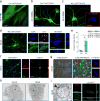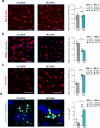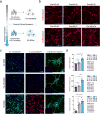Striatal neurons directly converted from Huntington's disease patient fibroblasts recapitulate age-associated disease phenotypes
- PMID: 29403030
- PMCID: PMC5857213
- DOI: 10.1038/s41593-018-0075-7
Striatal neurons directly converted from Huntington's disease patient fibroblasts recapitulate age-associated disease phenotypes
Erratum in
-
Author Correction: Striatal neurons directly converted from Huntington's disease patient fibroblasts recapitulate age-associated disease phenotypes.Nat Neurosci. 2020 Oct;23(10):1307. doi: 10.1038/s41593-020-00714-3. Nat Neurosci. 2020. PMID: 32879483
Abstract
In Huntington's disease (HD), expansion of CAG codons in the huntingtin gene (HTT) leads to the aberrant formation of protein aggregates and the differential degeneration of striatal medium spiny neurons (MSNs). Modeling HD using patient-specific MSNs has been challenging, as neurons differentiated from induced pluripotent stem cells are free of aggregates and lack an overt cell death phenotype. Here we generated MSNs from HD patient fibroblasts through microRNA-based direct neuronal conversion, bypassing the induction of pluripotency and retaining age signatures of the original fibroblasts. We found that patient MSNs consistently exhibited mutant HTT (mHTT) aggregates, mHTT-dependent DNA damage, mitochondrial dysfunction and spontaneous degeneration in culture over time. We further provide evidence that erasure of age stored in starting fibroblasts or neuronal conversion of presymptomatic HD patient fibroblasts results in differential manifestation of cellular phenotypes associated with HD, highlighting the importance of age in modeling late-onset neurological disorders.
Conflict of interest statement
The authors declare no competing financial interests.
Figures








Comment in
-
Cellular age in the manifestation of disease-relevant phenotypes in Huntington's disease.Mov Disord. 2018 Jul;33(7):1096. doi: 10.1002/mds.27425. Mov Disord. 2018. PMID: 30153391 No abstract available.
References
-
- Gusella JF, et al. A polymorphic DNA marker genetically linked to Huntington’s disease. Nature. 1983;306:234–238. - PubMed
-
- A novel gene containing a trinucleotide repeat that is expanded and unstable on Huntington’s disease chromosomes. The Huntington’s Disease Collaborative Research Group. Cell. 1993;72:971–983. - PubMed
Publication types
MeSH terms
Substances
Grants and funding
LinkOut - more resources
Full Text Sources
Other Literature Sources
Medical
Molecular Biology Databases
Research Materials

